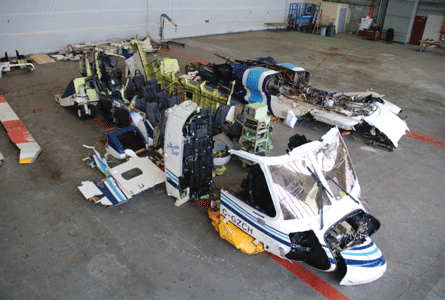18 February
18:35
ETAP Platform, North Sea
In the first accident a Bond Helicopters Eurocopter EC225 Super Puma (G-REDU) flew into the sea while the highly experienced captain was attempting a visual night-time approach to the ETAP Platform in poor visibility in the central North Sea. Both pilots and the 16 passengers survived with only minor injuries but although the aircraft's flotation gear deployed, the machine was damaged beyond repair.
The occupants successfully entered two liferafts but despite observers on the platform actually watching the aircraft ditch, even when the search and rescue helicopters arrived it was another 27min before the liferafts were located in a relatively calm sea. It was nearly two hours after the initial alert that the final survivor recovery was made.
Shortly after the accident Bond amended its operating procedures for night visual approaches to specify a visual gate point 2nm (3.7km) from the destination after which a go-around is mandatory if contact with the platform is lost or becomes uncertain.
The investigation highlighted a serious, but apparently little-known, problem with non-certified personal locator beacons carried by offshore workers suppressing the stronger signals of the electronic locator transmitters on aircrew lifejackets and the liferafts. The ELTs themselves were also not operated correctly by the personnel.
12 March
12:26
30nm east of St John's, Newfoundland, Canada
Between the two UK Super Puma losses a Sikorsky S-92A of Cougar Helicopters (C-GZCH) was lost in the North Atlantic when carrying workers to offshore installations. The crew reported losing main gearbox oil pressure and elected to return to St John's but crashed about 10min later during an apparent attempt to ditch. The aircraft sank and both crew and all but one of the 16 passengers died, although another escaped and was found dead in the water.
 |
|---|
© TSB CanadaOnly one person survived this S-92 accident |
Investigators found that the fatigue failure of titanium oil filter attachment studs led to the loss of oil pressure and an emergency airworthiness directive ordered their immediate replacement with steel units. It was also discovered that the main rotor continued to be powered until impact but the tail-rotor drive-gears failed for reasons not fully established, probably prompting the ditching attempt with both engines shut down. A flight manual revision now advises an immediate landing in the event of severe oil pressure loss.
The wide-ranging investigation is also examining: why the flight data recorder stopped before the engines; why the aircraft flotation collars did not deploy despite being armed; a series of training, human factors and crew resource management issues; and numerous survivability questions. A public enqury under retired Justice Robert Wells has been commissioned by the Canada-Newfoundland and Labrador Offshore Petroleum Board.
1 April
12:55
11nm NE of Peterhead, Scotland
Exactly six weeks after the first North Sea crash, a five year-old Bond Helicopters AS332L2 Super Puma (G-REDL) crashed suddenly into the sea from the cruise at 2,000ft (610m) returning to the mainland from the Miller Oil Platform in good conditions. A nearby supply vesssel quickly launched a fast rescue craft but both crew and all 14 passengers had been killed. An eyewitness on the ship reported seeing the main rotor blades, still connected to the hub, hit the water separately from the aircraft.
Investigators determined that the aircraft's health and usage monitoring systems had detected four metallic chips in the epicyclic gearbox of the main rotor gearbox 3min before the accident, but the system does not provide that information to the pilots. It was also discovered that the system had detected another chip in the same area a week earlier, leading to a programme of daily inspections of the aircraft which ended the day before the accident.
It has been determined that a failure within the epicyclic reduction gearbox module of the MRG resulted in the rupture of the gearbox case and the separation of the main rotor head. One line of enquiry seeks to understand the background to the analysis of the HUMS data that led to the MRG remaining in service with a view to improving the process.
EASA has issued an emergency airworthiness directive noting that "enhancement of the means for detection of main gearbox contamination was deemed of the utmost importance". It mandates an enhanced check programme and a modification to the chip collector inside the MGB to improve its early detection capability.
The investigation has revealed a complex failure mechanism, but its origin and progression are still being analysed.
Source: Flight International























